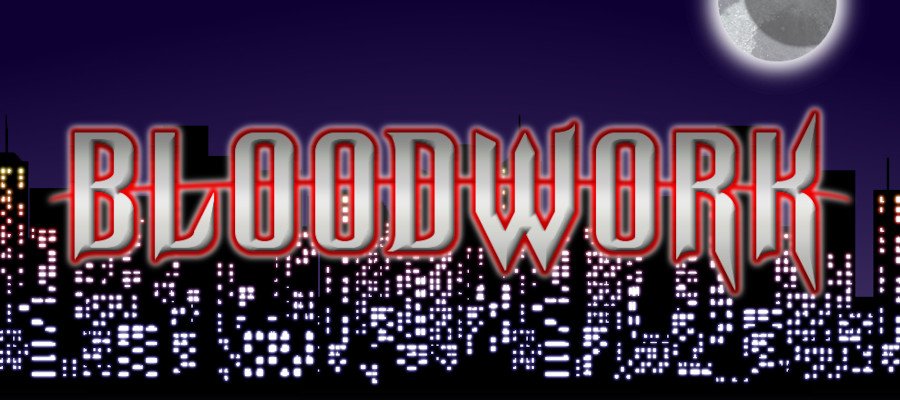Hey, we’re talking more about Bloodwork, the card game about building a network of vampires in the context of a 90s aesthetic representing new and interesting ways the society we live in is parasitic and we’re going whoosh okay.
Bloodwork wants to represent vampires operating in communities centered around the intention of a single entity creating an organisation to take advantage of opportunities. The player is a vampire of different types building organisations out of the available pieces that express themselves in different ways.
And y’know, the fact I’m calling them ‘organisations’ is part of the trick here, when we talk about the fiction. The language you use for a game is part of how the game feels and that’s part of what anchors detail. I got thinking about what I want to call a group of vampires, the way I want a group of vampires to feel. There’s a lot of different terms available… and I like a lot of them. I like how different terms for vampires create different vibes, like:
- Sabbbat
- Masquerade
- Cathar
- Brood
- Coven
- Circle
- Band
- Gang
- Order
- Family
Now, I thought about these terms a lot in the context of which one to use for the vampires in this game, but now, I think, the solution is to use as many of them as I can. Each type carries its own vibe for the vampire and its type. A brood feels like a sort of organic, packlike structure (Pack is another title option, huh). An Order feels more like a religious group, and a Band feels more aggressive.
But okay, so if each type describes a different type of vampire, then mechanically those need to feel different, and this means delving into what vampires mean in this situation. I’m a little torn here because I kind of like the idea of vampires as representing sorts of ‘wrong’ consumption, which can be either forms of modern horror and parisitism or the idea of the way that we have communities of people who are subsisting on capitalism’s surface the ‘wrong’ way.’
It’s the ‘queers or corporations’ dichotomy.
Another thing is like what surface do I have to convey this fiction? It needs to exist and explain the world, but also, importantly for the game, I don’t want there to be any element of the game rules that doesn’t connect to the fiction and I don’t want any fiction to be present that asks ‘hey, where are the rules for this?’
The main way I have to convey information about stuff in this game the faces of the cards. That’s front face and card back. There’s tokens, counters, and currency, box, rulebook, but the thing players are going to look at and are going to form the texture of what players build is the cards. Dice are probably going to act more, but that’s it.
This means that anything on the face of the card is going to need to be important. And now we’re running into a space where the abstraction and stuffness interleave. Because every thing that I need to convey fictionally demands space to do it. And things that the fiction needs and the cards can’t convey presents a potential problem.
These are vampires! What about day/night cycles? How do I represent them feeding? What don’t I need on the card, and if it’s on the card, do I have a fiction reason for it?
How specific do rules need to be on the cards? Do I need text boxes?
Cards can have names? But do they need them?
What about the numbers? You know, the numbers you roll?
What kind of thing can these abstractions represent on the limited space of a card?
And here’s an example of how the abstraction and the entanglement of the game design get snared with one another, and with the stuffness. The idea of a cost is something I assumed a card needs to convey, because it’s a resource and you’re acquiring resources. But that also suggests that people have, in the context of this fiction, that people have a price and that price is consistent. People are, you know, really good at accurately gauging their value, right?
If we strip away the cost function on a card, we need to find some other way to make it cost something. I tried a few versions of this idea, with a line representing value but now I’m liking a 3×3 grid. hen you pick a card, you have to put a blood counter on every card adjacent to it orthogonally. This means the card in the middle needs to be really good for you to bother taking it, but also, it will, over time, accumulate blood counters. When you take a card, you get all the blood counters on it. This means that cards become valuable just because of being left alone for long enough to accumulate value.
This creates a bunch of knock-on effects in the fiction:
- A thing is harder to obtain because of its relationship to other things
- Recruiting someone or something requires creating opportunities that others benefit from
- People don’t have a fixed price, it changes over time
That’s one element of the design shifting space and it lets me get rid of the costs.
Another thing to consider is the problem of the day-night cycle. The vampires shouldn’t be active all the time, so how do I want to handle day? Should there be human cards that can operate during an off-cycle part of the day?
When the game design started part of the point was that you were going to roll a dice and bluff it – either lie about what it showed or not – and that if everyone lied, and you didn’t, it meant you had a chance to get a sort of special artifact. There was a Prisoner’s Dilemma part of the game, about raiding an ancient tomb for the bodies of ancient vampires to claim power. That element isn’t really as important any more and I feel like it would involve adding another centralising element to the game – something that sits in the middle of the board and everyone needs to pay attention to it.
I think what I want is for the market to be central and maybe have a trench on a side where there’s another thing to track. Not super important, but something there, there’s room for a little bit extra.
But without that lying/truth element (since the dice are drafted), what does the night/day cycle look like? I think there should be cards that do things ‘during the day,’ which might mean they do things at the end of each turn? Or should half the turns be day turns?
Another thing is, there’s a lot of different ways to organise these differently flavoured vampire groups. Particularly, while a MLM scam looks like a pyramid, I want to also add crypto bro vampires, and they’d be decentralised, but also constantly cycling thralls as suckers, and quietly eating suckers discretely.
That means that suddenly, I have this new idea and direction based on the flavour: Each vampire type is building something different. The cryptobros are limited to six vampires, but they’re decentralised. Damaging one of them doesn’t damage all of them. My thinking there is they’re kind of ‘space base’ like – stacking effects on numbers, knowing that each vampire can be icked.
Another type, maybe a gang, is like a deck builder, their ‘night’ phase being when the card is in the discard.
Another type I’m thinking is a blackjack style. The dice roll represents how many vampires you can flip, and each extra card you flip can risk ‘busting.’
For six players, I need six game modes and I need to reconsider what demands they put on the cards. Is it possible that thralls aren’t cards, but are tokens, and you can cash them in when you turn them for Young Vampires in the marketplace?
Anyway, notes.




